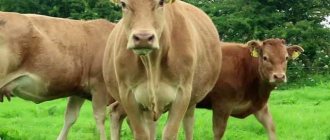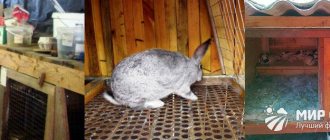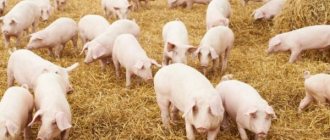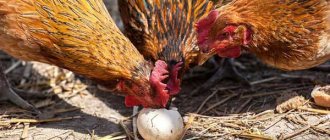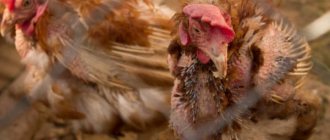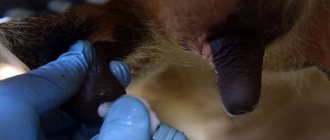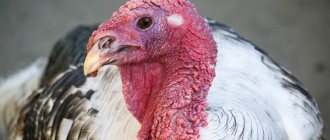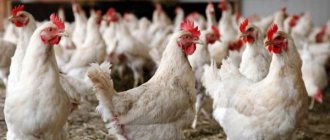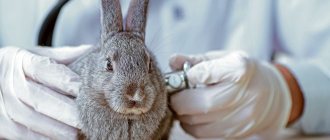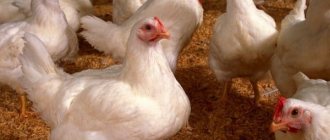Non-communicable diseases
These diseases can occur due to injury, improper or insufficient nutrition, poor-quality feed, intoxication with poisonous plants or pesticides, improper care and lack of hygiene.
A healthy goat is always cheerful and has a good appetite. Normal pulse rate is 70 - 80, breathing is 15 - 20 per minute, temperature is 38.5 - 40 ° C, up to 41 ° C in kids.
If a goat has lost milk, has a rapid heartbeat, fever and poor appetite, then it means it is unhealthy and it is necessary to find out what the cause of the disease is.
Important! In case of any illness, you need to contact a veterinarian; this can save both the health of the sick animal and the healthy individuals around it.
Avitaminosis or hypovitaminosis
Vitamin deficiency usually occurs in kids and young animals due to a lack of vitamins (A, D, less often B, C, E) and minerals in food.
Vitamin deficiency is expressed in slow growth of livestock, loss of appetite, unsteady gait, cramps, and leg failure. In adult animals, deterioration in reproductive functions is observed.
How to understand that a goat is sick - the main signs of the disease
With proper care and proper feeding, goats rarely get sick. However, every owner needs to be able to distinguish a sick goat from a healthy one, provide first aid to a sick animal if necessary, and carry out all necessary preventive measures together with the veterinary service.
You need to know that a healthy goat has a pulse rate of 70–80 beats per minute, the number of respiratory movements in one minute is 15–20, and the normal temperature is 39–40 degrees. The body reacts to almost all infections by raising the temperature to 41 - 42 degrees. At the same time, the pulse also increases and becomes 100 beats per minute, breathing quickens and reaches 80 - 90 movements per minute, resulting in shortness of breath. At the same time, goats become lethargic, eat food poorly or stop eating altogether. Very often the secretion of milk stops, sometimes the stool changes, the condition of the mucous membranes and skin changes, the coat loses its shine and becomes disheveled.
If you notice similar signs or any other changes in your pets, it would be better to contact a veterinarian for advice and, if necessary, help. If the diseases are non-contagious, the livestock breeder can provide first aid himself, having the necessary knowledge about the disease and an idea of their possible treatment. Quite a lot has already been written and said about various diseases of goats. I would like to pay special attention to the particularly serious and dangerous ailments of these domestic animals, since they cause the heaviest damage to goat farms and can even be dangerous to humans.
Infectious diseases
They arise, as we mentioned, when infectious microbes enter the body. We will briefly describe the most common goat diseases and treatment methods.
Infectious pleuropneumonia
In nature, there are microbes of the mycoplasma genus, which, penetrating into the body, cause inflammation of the lungs and pleura. These diseases are dangerous for young goats under three years of age. You can become infected by interacting with sick or already ill individuals. The causative agent of the disease is transmitted through coughing, runny nose and urine.
Symptoms:
- the temperature rises sharply;
- loss of interest in food;
- chewing gum disappears;
- depressed look;
- muscle tremors;
- barking cough followed by a wet cough;
- mucopurulent mucus runs from the nose;
- wheezing is heard when inhaling and exhaling.
Treatment.
- The sick are separated from the rest of the herd, the barn in which they were previously located is sanitized and disinfected.
- Goats are prescribed “Novarsenol” with glucose, “Osarsol”.
Infectious mastitis
Caused by a pest that penetrates the udder. You can become infected during communication with individuals who are already affected by mastitis or are just carriers of the microbe.
The infected udder turns blue-violet
Symptoms:
- the infected part of the udder grows and hardens;
- gets a blue-violet tint;
- A watery slurry flows out of the udder, followed by blood and pus;
- burns heat;
- chewing gum disappears;
- loss of appetite.
If a goat gets sick with infectious mastitis, resort to the following measures.
- Sick pets are transferred to an isolation ward.
- The udder needs to be massaged and milked frequently.
- In difficult cases, intramuscular injections of Penicillin and Erythromycin are prescribed, and Norsulfazole is administered orally.
- Streptomycin or special compounds that inhibit the development of infection are administered through the nipples.
Brucellosis
A sick animal can transmit infectious germs to humans. The carrier of brucellosis comes out during abortion, with amniotic fluid and blood. The microbe enters the body through food, drinking water and through contact with affected individuals.
An effective treatment has not yet been developed, therefore the infected animal is killed. The room where it was kept is treated and disinfected so that brucellosis does not develop in the rest of the livestock.
Necrobacteriosis (hoof disease)
The infection enters the body through scratches on the skin and saliva and mucous membrane. It affects the interhoof gap, crumbs and corolla. It is transmitted through contact with a carrier of the microbe through saliva, manure and necrotic cells.
Symptoms:
- the goat begins to limp;
- the tissue on the hooves becomes swollen;
- purulent-necrotic formations appear;
- in difficult situations, the horny shoe falls off, the infection penetrates the lips and mouth;
- the desire to eat is lost.
Complex treatment.
- Affected areas are disinfected.
- If the disease has just begun, antibiotics that act for a long time are used (Terramycin, Cobactan).
- Medicines are prescribed to strengthen the immune system.
- In special cases, local surgery is resorted to.
Footrot
Infection manifests itself in the form of putrefactive decomposition of the hoof horn. Along the way, the sole and walls of the hoof peel off.
The affected hoof may be at risk of necrosis
Symptoms:
- sick people limp on the affected leg;
- the area through which the infection has penetrated turns red and begins to swell;
- in severe cases, gangrene or necrosis of the hoof occurs.
The following treatment helps.
- Sick individuals are isolated, and the goat's rue is disinfected.
- Affected hooves are treated with disinfectant compounds.
- In difficult situations, festering areas are cut off surgically.
foot and mouth disease
Doctors call the causative agents of the disease a number of types of RNA-containing viruses. Immediately after entering the goat’s body, the virus multiplies vigorously, first infecting epithelial cells (creating bubbles), and then spreading throughout the body.
A goat can get foot and mouth disease due to carriers of the virus, sick or already recovered individuals. The virus enters the body through the mouth and mucous membrane, through scratches on the udder and limbs.
Symptoms of foot and mouth disease:
- temperature rises;
- passivity, depressed state;
- milk yields are falling;
- after a few days, small ulcers appear in the mouth, on the wings of the nose, on the udder and hooves, which burst within a couple of days;
- loss of appetite;
- lameness.
There is no specific treatment for foot and mouth disease yet. Usually several procedures are used.
- Sick goats are isolated, and the room where they were located is disinfected.
- Affected areas on the body are disinfected.
- The hooves are smeared with warm birch tar.
Non-communicable diseases
The reason for the development of pathologies of this group in small cattle most often lies in improper care of animals. Their formation can be provoked by:
- poor nutrition;
- failure to comply with hygiene requirements;
- poisoning;
- injuries of various types, etc.
Now let's get acquainted with the main non-communicable diseases that goats can develop.
Abdominal bloating in a goat during tympany is especially pronounced on the left side.
Acute tympany
The formation of acute tympany is most often observed during summer grazing, since this disease is directly related to the violation of feeding goats with green food. The pathology occurs only in acute form, so treatment must be started immediately.
When tympania occurs, large quantities of gases accumulate in the animal's rumen. The reason for this phenomenon is the fermentation process provoked by plant feed.
The best option is to immediately call a veterinarian, but in cases where this is not possible, it is recommended to proceed as follows:
- Lift the goat by its limbs and place it vertically so that only the hind limbs serve as support.
- Pull out the animal's tongue and place a straw rope in its mouth.
- Massage the goat's belly, pouring cold water over it as you go. During the massage, the horned one needs to drink 500 ml of water, having previously diluted ammonia, kerosene or creolin in it in a volume of 1 teaspoon.
With an advanced form of tympany, when the goat’s life is in danger, you can resort to emergency measures: with a sharp movement, pierce the goat’s scar using a trocar surgical instrument. The area where the puncture is performed is the hungry pit of the individual.
With gastroenteritis, goats experience severe malaise and weakness.
Gastroenteritis
Gastroenteritis of small ruminants presents difficulties in the functioning of some parts of the digestive tract - abomasum and intestines. Most often, this disease involves the development of severe inflammatory processes, affecting, in addition to the mucous membranes, muscle tissue with a serous layer.
Therapeutic actions for gastroenteritis differ depending on the age of the animal.
Coping with gastroenteritis in sexually mature individuals is quite difficult. In this case, you should definitely seek help from a veterinarian. If this is not possible, we suggest proceeding as follows:
- To cleanse the animal's stomach and speed up bowel movements, give it castor oil.
- Antibiotic therapy is required for 5-7 days. For this purpose, you can use phthalazole or sulgin. The dosage of the drug is calculated as follows: per 1 kg of live body weight, 0.2 g of the drug.
- In parallel with antibacterial drugs, it is necessary to undergo a course of treatment with intestinal disinfectants. From this group of drugs, it is recommended to use ichthyol, resorcinol or Lysol for therapeutic purposes.
To stop profuse diarrhea, the goat must also be given one of the following natural remedies:
- oak decoction;
- flaxseed or oat seed infused in boiling water.
This drink has an enveloping and astringent effect and will help relieve intestinal problems.
To prevent dehydration, it is necessary to administer saline to the animal intravenously or subcutaneously. If problems with the heart occur, glucose is administered intravenously.
Do not forget that each animal’s disease progresses individually. Drugs that can alleviate the condition in one goat may delay recovery for another goat.
To cure seasonal gastroenteritis, which manifests itself, for example, in the fall, you can use a proven farm remedy that you can prepare yourself:
- Take garlic (200 grams), wash off the dirt, place it directly in the skin into a container and pour ethyl alcohol (1 liter) into it.
- Place the container with the resulting composition in a dark place and leave for 14 days. When gastroenteritis begins to bother the goat, you need to take 5-10 ml of the solution and dilute it with water in a ratio of 1:3.
- A sick goat should be given the mixture three times a day until the condition improves.
As for the treatment of young animals, they should be isolated in a separate pen with the queens. If there is no separate quarantine zone in the barn, you can allocate something similar to a tent with a wooden frame, where it will be quite warm, for the duration of the goat’s illness. This must be done if the disease develops in the off-season, when the weather is very unstable.
Mothers of sick cubs should be fed nutritious food and mineral supplements:
- cereals;
- mixed feed;
- mineral and salt stones;
- chalk.
Babies cannot be fed for 24 hours; they can only be given clean water. When the baby goat must be fed, since it is still too small, it is recommended to replace the milk with yogurt, diluting it in warm boiled water. The baby should be fed this way 4 times a day.
On the second day, young animals with mild gastroenteritis should be sent out together with their queens for walking. If the disease occurs in a more severe form, the kids should continue to be kept in stalls and fed them:
- quality grain;
- good feed;
- fish oil and vitamins;
- green hay – maximum 500 grams per day;
- meat and bone meal;
- additives containing copper salts.
There is no need to treat the cubs, but if there is no effect from the diet, you should call a veterinarian for advice and choose medications that are suitable specifically for your case.
Most often, treatment of goat kids for gastroenteritis is:
- soldered with warm sodium chloride;
- in the use of antibiotics (phthalazole or sulgin).
Inflammation of the lungs (pneumonia)
Anyone has heard about this disease. A distinctive feature of this pathology is that it often develops as a concomitant disease against the background of existing ailments. As a result, if your goat has been seriously ill in the recent past, you should not prematurely rejoice that complications did not follow. An inflammatory process in the lungs can develop at any time.
Therapy against the background of this pathology is carried out in the same way, regardless of the age of the animals.
To begin with, sick goats need to be transferred to a warm and dry room. If there is no separate building for animals on the farm, you can place the pet on the heated veranda in your home. Such measures are necessary, since constant drafts or even slight humidity will worsen the course of pneumonia. Because of this, the treatment will not have the desired effect. Although just transferring to a warm room is not enough for a complete cure.
The next step to speed up the goats' recovery is to create a special menu. The diet during illness should include high-energy foods. A goat with pneumonia should be fed:
- clean hay in moderation;
- grains and legumes;
- mixed feed.
An important component of the diet during the entire period of illness are vitamin and mineral supplements in the form of:
- salt licks;
- mineral stones with vitamins;
- chalk.
It is recommended to feed small goats with fish oil to reduce the effects of the pathology. Warm water should be used as a drink for sick individuals to avoid hypothermia, but if it cannot be heated, the water should be at least room temperature. Moreover, drinking water should be available at all times. Thanks to plenty of drinking, increased intoxication in the body, which manifests itself as a characteristic symptom against the background of pneumonia in small cattle, is reduced.
Sick animals must be given antimicrobial agents, otherwise it is almost impossible to achieve the desired result. From this group of medications, goats should be treated with penicillin or norsulfazole.
The duration of the disease in each specific case is individual. If you start treatment in time, you can significantly speed up recovery.
The lack of vitamin and mineral complexes in the diet affects the health of not only adult animals, but also young animals.
Avitaminosis
This disease is a deficiency of vitamins A, B, C, D and E in animal nutrition. Many will think that this is an insignificant problem, although this disease is fraught with serious consequences for the formation of various vital systems in the body of goats.
Treatment of vitamin deficiency involves feeding livestock with fortified feed and additional supplements. To improve the condition of your pets, you should increase the serving size:
- carrots;
- bran;
- sprouted grains.
Also, to combat vitamin deficiency, animals should be fed:
- fish oil;
- yeast;
- meat and bone meal;
- milk.
You can tell that an animal has developed ketosis by the strong smell of acetone - it smells like milk and other waste products - feces, urine.
Ketosis
With this disease, the metabolism of animals is disrupted. As the disease progresses, the level of ketone bodies in the bloodstream increases, which negatively affects liver, kidney, heart and other functions.
Therapy for ketosis involves changing the livestock menu. The diet should be based on hay from high-quality meadow vegetation and fresh grass. In addition, food needs to be replenished with concentrates:
- grain legumes;
- bran;
- mixed feed.
It is also recommended to diversify the menu with high-quality haylage.
Until complete recovery, goats are prohibited from feeding:
- silage (at first even low-acid);
- pulp;
- Barda;
- spoiled, stale food.
Goats also need to be fed with vitamin complexes, for example, gamavit, eleovit, etc.
In addition, intravenous administration of a 5% glucose solution in a dosage of 10 ml is required, and the addition of propylene glycol, sodium propionate, and cholinol to food.
To reduce acidity in the rumen, baking soda is used at a rate of 20 g per animal for 14 days.
Intoxication
The reason for the development of intoxication lies in the consumption of feed by livestock that has previously been treated with pesticides, poisonous vegetation, or substances that are not intended for food.
Therapy for this disease consists of eliminating the toxin and reducing negative reactions in the body. In this case it is necessary:
- rinse the stomach;
- feed a laxative;
- drink activated carbon.
This treatment will not help with some toxins. In this case, the introduction of an appropriate antidote is required.
Mastitis
Mastitis is an inflammatory process in the mammary glands of the goat's udder. The development of pathology is possible under the influence of many factors.
Therapy for mastitis is carried out in accordance with the following instructions:
- A sick goat must be placed in a separate, dry, clean and warm room. The floor surface must be covered with straw, which is replaced as needed.
- During treatment, animals are prohibited from feeding foods that promote milk production: root vegetables, melons, fresh herbs, fruits, and combined feeds. At this time, the goats' diet should consist of hay and branches, which helps maintain the nutritional value of the feed at the proper level. The volume of drinking should be reduced to 2 liters per day.
- The animal must be milked at least 4 times a day. To reduce pain during milking and accelerate the resorption of swelling, the udder should be rubbed with ichthyol ointment.
- Animals require weekly antibiotic therapy with penicillin, cefazolin, streptomycin, etc.
- For injection into the nipples, you can use mastomycin, mastiet, mastisan, etc.
- To maintain immunity, you need to undergo a course of treatment with immunofan, catozal or trivit.
Udder furunculosis
With this disease, the goat's udder becomes covered with boils (inflammatory lesions). They appear on hair follicles. The main reason for the formation of this pathology is a violation of hygiene standards when keeping animals.
Therapy for furunculosis proceeds according to the following scheme:
- To soften the crusts on the boils, the udder should be washed with soap, and certainly in warm water.
- Soak a cotton swab in an antiseptic, use it to get rid of crusts and cut the hair.
- Treat each lump with iodine. Further actions include maintaining mammary gland hygiene, proper feeding of animals with the obligatory addition of vitamin supplements.
With rheumatism, the animal's joints swell, lameness appears, body temperature rises and appetite disappears.
Rheumatism
This disease develops when kept in a room with high humidity and drafts.
Therapy for rheumatism depends on the form of the disease. Muscular rheumatism involves transferring the animal to a dry and warm room in combination with rubbing with camphor alcohol. If an articular form of the disease is detected in a goat, it is given sodium salicylic acid. External use of ointments based on:
- turpentine;
- ammonia;
- vegetable oil.
Fascioliasis
Fascioliasis is a disease caused by parasites. These are flat helminths, from which the name of the disease comes - Fasciola. Once inside the animal’s body, they settle in its liver and bile ducts.
Helminth infestation is a common problem in livestock.
The following sources of helminth infestation exist.
- Grazing on unfavorable pastures infected with parasites. Goats eat food and swallow Fasciola along with it.
- From infected goats, the infection spreads to others.
Symptoms
When helminths enter the body, the following symptoms begin to develop.
- The depressed state of the goat manifests itself very quickly.
- Lack of appetite or sluggish eating of food.
- The body temperature of an individual can reach 41°.
- At first the animal diarrhea, then suffers from constipation.
- The animal's chest and jaw swell.
- Obviously, the mucous membranes turn pale and acquire a yellow tint.
Treatment
The disease is treated with anthelmintic drugs:
- octvicol;
- dertila;
- acemidophene;
- ursovermite, etc.
Moniesiosis
Another disease caused by helminths, already tapeworms, living in the small intestine of goats. Animals become infected by eating an oribatid tick, which is a carrier of parasites. Its braids may be swallowed in the pasture in spring or fall.
Types of parasites that inhabit the body of goats
Symptoms
Symptoms of the disease do not appear immediately, but after about 25-30 days.
- Animals lose a lot of weight and become lethargic.
- The fur begins to lose its shine and falls out in places.
- Mucus and pieces of helminths can be found in manure.
If decisive action is not taken, the animal's intestines will become so clogged with worms that an obstruction will occur and the animal will die.
Treatment
Also carried out with anthelmintic drugs:
- Cambendazole;
- phenalidone;
- copper sulfate;
- fanadecom, etc.
If only part of your herd is infected, it would still be a good idea to feed anthelmintic drugs to the rest of the herd to avoid further consequences.
Parasitic diseases
Pathogens are various living organisms that can parasitize inside or outside the body of an animal.
Fascioliasis
It develops when the flat helminth Fasciola enters the animal. Organisms collect in the liver and bile ducts. The infection can be picked up on pastures, where there is a favorable environment for the development of helminths. Once infected, a goat is capable of infecting other relatives.
Symptoms:
- temperature rise in young individuals up to 42°;
- depressed, lethargic state;
- loss of appetite;
- diarrhea alternates with constipation;
- swelling of the lower jaw and chest;
- gradual development of anemia;
- the mucous membranes become pale and then turn yellow.
Treatment.
- The individual is isolated.
- Antihelmintic drugs are prescribed. Acemidofen, Acetvicol, Dertil, Ursovermit, Fascoverm, Fasinex are suitable.
Moniesiosis
The disease is caused by tapeworms. Once in the body, they accumulate in the small intestine. A goat can become infected with moniesiosis on pasture by feeding on grass in which oribatid mites, carriers of parasites, live. This usually happens in spring or autumn.
With moniesiosis, the goat loses a lot of weight and its color becomes faded.
The initial symptoms of infection become noticeable after a month. The manifestations are as follows:
- sick individuals lose weight;
- the coat becomes dull;
- apathetic, sluggish state;
- the stool takes on an unformed, mucous appearance; segments or entire fragments of the helminth can be seen in them.
The disease is especially dangerous for children - when formed in large numbers, worms in goats can completely block the intestines, which ultimately leads to death.
Treatment.
Livestock are prescribed special anti-worm medications. The most effective are:
- “Fenasal”, “Fanadek”, “Fenalidon”, “Panacur”;
- copper sulfate;
- "Albendazole", "Cambendazole".
The compositions are prescribed individually to each individual or the entire herd is treated with them.
Echinococcosis
The causative agent is cestode larvae. Penetrating into the body of small cattle, parasites accumulate in the liver, lungs, spleen and kidneys. They pose a danger to humans. Animals can become infected with echinococcosis by eating food containing eggs and segments of cestodes.
Symptoms:
- sick individuals lose weight;
- the digestive system is malfunctioning;
- jaundice forms;
- if the parasites settle in the lungs, the goat begins to cough, breathes with difficulty, and shortness of breath appears.
No effective treatment has been developed for this disease.
Dictyocaulosis
The causative agent is a filamentous helminth nematode. Having entered the body through contaminated food and drinking water, the parasite develops in the bronchi and trachea.
Scheme of development of dictyocaulosis:
Symptoms:
- the animal loses interest in food;
- passive, lethargic state of health;
- cough;
- the runny nose takes on a thick form;
- swelling appears;
- anemia.
To cope with dictyocaulosis, certain treatments are used.
- A sick pet is prescribed an aqueous solution of iodine, which is injected into the trachea using a syringe.
- Ditrazine is injected as an injection - it is considered a very effective remedy for dictyocaulosis.
Strongylatosis
The causative agent is roundworms of the suborder Strongylate. Parasites accumulate in different areas of the digestive tract: in the stomach, small and large intestines. An animal can become infected with strongylatosis by consuming food and drinking water containing larvae and eggs.
If a goat is sick with strongylatosis, the hair becomes dull and falls out more intensely.
Symptoms:
- gastroenteritis, dermatitis, pneumonia are formed;
- diarrhea;
- the fur becomes dull and falls out easily.
Treatment.
- Sick animals are prescribed anthelmintics and drugs to strengthen the immune system.
- They use Phenothiazine, copper sulfate.
Piroplasmosis
Pathogens are simple organisms that parasitize the red blood cells of the circulatory system. The carrier of piroplasms is the ixodid tick, which bites animals on pasture in spring and autumn. Adults of any breed are affected. Young goats rarely go to pasture, so they practically do not become infected.
Symptoms:
- temperature rises;
- anemia develops;
- mucous membranes turn yellow;
- the health of the livestock is deteriorating;
- appetite decreases;
- rapid pulse, difficulty breathing;
- diarrhea;
- the animal's urine turns dark red as hemoglobin appears in the kidneys.
Treatment.
- Sick individuals are isolated.
- The diet consists of high-quality dietary feed.
- Special medications are prescribed: Azidine, Diamidine.
- Symptomatic therapy is prescribed.
Linognathosis
The carrier of the disease is lice, passing from sick individuals to healthy ones. Infectious goat lice can be transmitted through the use of shared hygiene products.
Symptoms:
- sick individuals begin to itch;
- milk productivity decreases;
- if there are a lot of parasites, the goat behaves restlessly;
- loss of appetite;
- extensive dermatitis is noticeable on the head, neck and chest;
- wool falls out.
Treatment.
- The sick are subjected to primary treatment with insecticides. The preparations in the form of a solution, emulsion or aerosol are sprayed onto the animal’s skin. In this way, it is possible to get rid of lice larvae, curing pediculosis at an early stage.
- The next treatment is carried out two weeks later. Solutions of “Chlorophos”, “Karbofos”, as well as “Foxim”, “Acrodex”, “Perolom”, “Insectol” are used.
Cestode echinococcosis
The disease is provoked by a cestode larva, which inhabits the body and settles in the liver, kidneys, lungs, spleen and other organs of goats and humans. Infection occurs from low-quality food and water, which contain parasite eggs.
Symptoms
The course of the disease is accompanied by the following symptoms.
- Serious weight loss of horned wards.
- Frequent diarrhea.
- Jaundice.
- The animal is coughing and has difficulty breathing.
One of the symptoms of parasite infection is severe weight loss of the animal.
Treatment
Treatment has not yet been developed, so goats are sent to slaughter and carefully disposed of so as not to infect the entire herd.
Dictyocaulosis
Infection of a goat's body with a filamentous helminth, which colonizes the trachea and bronchi. It also enters the body along with food or water.
Symptoms
The symptoms are similar to other types of helminth infections, but add to them:
- stringy nasal discharge;
- anemia;
- swelling.
Treatment
Treatment of dictyocaulosis consists of infusion of iodine solution into the trachea, as well as administration of ditrazine injections.
Diseases of the genitals
Therapy is prescribed after identifying the severity. In severe cases, antibiotics are used. The outcome of treatment is unpredictable due to many factors influencing the healing process and the final result.
- Orchitis is an inflammation of the testes of males. Accompanied by fever and depressed mood.
- Complete or partial prolapse of the vagina and uterus in the second half of pregnancy.
- Vulvitis is inflammation of the vulva.
- Vaginitis is inflammation of the vagina.
- Vestibulitis is inflammation of the vaginal vestibule.
- Endometritis is an inflammation of the uterine mucosa.
Piroplasmosis
The disease occurs when an ixodid tick bites, when grazing in forest or forest areas. Animals of any age can get sick.
Piroplasmosis is transmitted in the secretions of the ixodid tick
Symptoms
Thanks to the following symptoms, the early onset of the disease can be determined:
- increased body temperature;
- anemia;
- yellowing of mucous membranes;
- general weakness;
- decreased appetite or refusal to feed;
- fast, weak pulse;
- rapid breathing;
- diarrhea appears;
- the animal's urine turns red.
Treatment
Animals are treated using injections of the following drugs:
- azidine;
- diamidine
At the same time, therapy is carried out aimed at relieving symptoms and the animals are fed dietary food.
Prevention
Despite the huge number of diseases of the goat body, all these problems can be avoided if you follow a number of recommendations, properly care for the animal and feed it only with selected feed. It is also necessary to choose the right place for the animal to walk - with clean grass and the absence of plants dangerous to the animal.
These preventive measures will allow the farmer to avoid losses and financial surpluses.
Lice in goats
Lice settle on animals and, upon contact, jump to others, infecting the entire herd.
Symptoms
Symptoms of an individual with lice include:
- anxiety in goats due to widespread itching;
- low animal productivity;
- decreased appetite;
- the appearance of dermatitis and hair loss.
Video - Treatment of goats for lice, worms, diarrhea
Treatment
Killing lice is carried out with insecticides, such as to destroy not only adult individuals, but also the larvae laid by them. Spraying is carried out with solutions:
- Phoxim;
- chloroforce;
- carbofors;
- Arrodex, etc.
A secondary treatment of the animals must be carried out two weeks after the first, in order to prevent the hatching of larvae in any case.
Remember, you should not treat animals on your own; entrust this work to a veterinarian to prevent the disease from spreading to the entire herd.
Non-communicable diseases
They are not transmitted to other animals and humans. Occur after mechanical trauma; unbalanced diet; violations of conditions of detention.
Cracked nipples
The main reason is a violation of milking technique. Secondary - dirty enclosures with wet bedding. Cracks develop into mastitis when bacteria enter. When milking, the goat experiences pain and shows anxiety. Treat the udder with a solution of boric acid and lubricate it with petroleum jelly, ointment with propolis or solcoseryl. For quick healing, use aloe and compresses with alcohol tincture of nettle.
Mastitis
Affects the mammary glands. Develops due to improper milking, injury to the udder, dirt, and drafts. The affected udder is hot and hard to the touch. After milking, flakes and pus are visible in the milk. Sick goats are often milked because the milk weighs down the udder. Rub camphor oil on the affected areas to reduce swelling. They give a laxative based on water, vegetable oil with two tablespoons of Glauber's salt (a glass of oil per half a liter of water). Antibiotics are required: Dorin, Ceftriaxone, Cobactan, Nitox.
Rickets
Vitamin D deficiency in goat kids. The hooves are tucked in, the legs are weakened. Recovery takes a long time: vitamins A, D, and calcium phosphorus are introduced into the diet. The only prevention is to prevent rickets by maintaining the balance of vitamins and microelements in the feed.
Arthritis, arthrosis
Chronic, difficult to treat. The joints change shape, swell, and hurt. The animal cannot lean on the affected limbs. The goats are provided with rest with water and food. Therapy is carried out with regular massage with joint ointments and liniments.
Ketosis
Metabolic disorders from excess protein, high content of butyric acid. Goats that are overweight, pregnant or lactating are more affected due to decreased activity. Observed: constipation, lethargy, rapid breathing, slow weight gain, drop in milk yield. The diet should consist of meadow grass hay, bran, and legumes. Vitamins – Eleovit, Gamavit. A 5% glucose solution is administered intravenously.
Acute rumen tympany
Gas formation and fermentation in the rumen. The reason is eating greens on an empty stomach; drinking plenty of water before grazing. Tympany is caused by alfalfa, clover, corn cobs, apples, cabbage leaves, carrot and beet tops, and moldy grain. Goats refuse food; wag their tail rapidly; bleat; frequent bowel movements. Without timely help, the stomach swells; gait is unsteady.
Stages of treatment:
- the goat is raised on its hind legs;
- the tongue is pulled out and a straw tourniquet is placed in the mouth;
- The stomach is massaged with cool water;
- For greater effectiveness during massage, drink a solution - pour 1 teaspoon of kerosene, creolin or ammonia into half a liter of water, to choose from.
Before grazing, feed dry hay, without water. Don't put goats on grass with dew.
Prevention of diseases in young animals
Preventing the development of a disease is much easier than treating it later. Especially in animals from which it is planned to produce high-quality milk, meat or offspring in the future.
To protect a newborn goat, its health must be taken care of in the prenatal period:
- First of all, it is necessary to create appropriate gestation conditions for the goat. Temperature, air humidity, walks. Particular attention must be paid to the diet.
- Secondly, the goat house must be equipped so that there are no drafts or cracks. Thirdly, it is necessary to strictly control that all necessary minerals and elements enter the body.
What are goat diseases?
It is customary to divide animal diseases into two groups: infectious, which spread from the carrier to “brethren,” and non-infectious. The second type is not transmitted to other horned animals. The cause of such ailment is often improper care and poor living conditions.
It cannot be said that non-communicable diseases do not require treatment and that everything will “go away on its own.” The goat requires attention and care; it is important to provide the right diet during this difficult period.
In order to recognize the problem in time and prevent complications or even more unpleasant consequences, it is important to understand goat diseases, the main symptoms, treatment methods, and follow the rules of care, which at this time should be more intensive.
